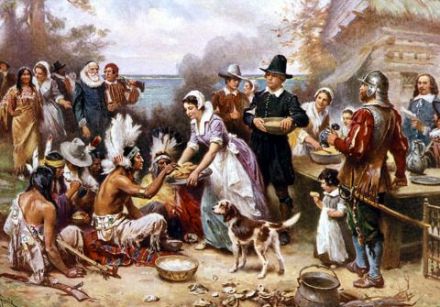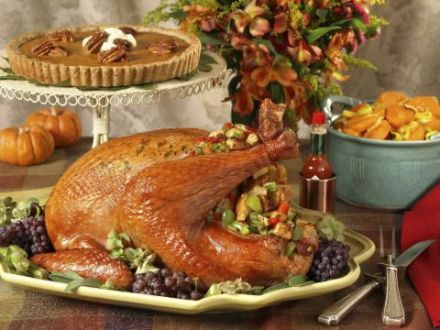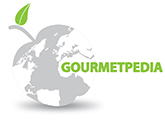
Thanksgiving - A Celebration of Plenty
Did you know that eight nations of the world have official Thanksgiving Days? Those countries are Argentina, Brazil, Canada, Japan, Korea, Liberia, Switzerland and the United States.
The tradition of declaring a special day or period for giving thanks is an ancient one. It dates far back to the time when our ancestors hoped that an ostentatious display of gratitude would placate their capricious gods - thus ensuring continued bounty. But these days of thanksgiving were also occasions for celebrating the year's plenty with feasts and joyful gatherings. The thanksgiving celebrations of the ancient Greeks took the form of an annual fall festival, during which offerings were made to Demeter, the goddess of corn. Every October the Romans held a harvest festival called Cerelia, in praise of Ceres (Demeter's Roman counterpart) which included games, parades and a feast. The Jewish harvest festival, Sukkoth, is still celebrated every autumn as it has been for 3000 years.
One of the most well-known symbols of Thanksgiving also dates back to ancient Greece. The cornucopia or "horn of plenty" comes from the myth in which Zeus gave Amalthea (who had fed him with goat's milk when he was an infant) one of the goat's horns as a gesture of thanks, with a promise that it would bring an abundance of anything she wished for.
Proclaiming days of Thanksgiving for various reasons - success in war, a bounteous harvest, the recovery of a king from illness - was part of European tradition for centuries. The first rite of Thanksgiving to be held in North America took place in 1578, when English explorer Martin Frobisher arrived in Newfoundland and ordered that a ceremony be held to thank God for protecting his crew during the long and dangerous sea voyage.

However, much of modern North American Thanksgiving lore is associated with the Pilgrims. In 1621, a year after arriving in the new world on the Mayflower, and following a severe winter in which many of their numbers had succumbed to disease, the colonists celebrated their first successful harvest by organizing a thanksgiving feast to which they invited the neighboring Native Indians. On the menu for that first American Thanksgiving were almost certainly some foods that have become staples of the holiday - turkey and pumpkin - along with other wild fowl, venison, oysters, clams, fish, corn cakes, and wild fruit and nuts.
Why do Americans celebrate Thanksgiving on the fourth Thursday of November?
Because President Abraham Lincoln declared this day a holiday in his famous Thanksgiving Proclamation of 1863. Yes, but who was behind this decision? The answer is Sarah Josepha Hale, one of the most important, yet least recognized, women in American history. She lobbied the President to officially proclaim a day of Thanksgiving, convinced that observing it on a national level would bind the warring country together and ensure peace.
In Canada
During the American Revolution, many colonists desiring to remain loyal to the British crown headed north to Canada, bringing with them many New England traditions, explaining the continuing similarity of many US and Canadian Thanksgiving customs and menus. Following European tradition, general days of Thanksgiving had been officially proclaimed in Canada since 1799 to celebrate royal events or the end of wars or epidemics. By the latter part of the nineteenth century, a day of thanksgiving for an abundant harvest was proclaimed each year for a Thursday in November, later moving to October, perhaps because of Canada's colder climate and earlier harvest. Eventually Thanksgiving came to be celebrated on a Monday, though in the 1920s Thanksgiving was once again observed in November, the Monday before Armistice Day. Finally in 1931, Canadian Thanksgiving was fixed for the second Monday of October, a move formally enshrined by Act of Parliament in 1957.
But enough about history! What's for dinner?
On most North American tables, a turkey still holds pride of place for the annual Thanksgiving feast. In the US alone, over 40 million turkeys are consumed on this holiday weekend each year! It is usually accompanied by gravy and stuffing, the particular accents of which are determined by region. Along the eastern seaboard, oyster stuffing is traditional, hearkening back to the days when these shellfish were a cheap and plentiful source of food. In the south, you are more likely to find cornbread stuffing, while in the northern US and Canada you might find wild rice among the ingredients for the turkey dressing. Cranberry sauce is traditional, made with fresh or frozen berries, or perhaps in the form of a jiggly cylinder that slides out of a can! A staple of many American Thanksgiving dinners is sweet potatoes, combined with sugar, spices and butter, turned into a casserole and sometimes topped with marshmallows. Other vegetable dishes, salads, pickles and rolls usually round out the meal, followed by the traditional pumpkin pie and whipped cream. In many households, a final Thanksgiving tradition is to retire to a comfortable chair to loosen one's belt!

Apricot-Glazed Roasted Turkey Breast
Turkey with wine-simmered fruit stuffing
Roast turkey with chanberry orange glaze
Southern Roast Turkey with Bourbon Peach Glaze - Louisiana
Cranberry and Orange Sauce
Maple Praline Sweet Potatoes
Spiced pumpkin Pie
Painting: The First Thanksgiving by Brownscombe
Collection of Pilgrim Hall Museum

-

 Recipes
Recipes
-

 Products
Products
-

 Entertaining
Entertaining
-

 Chefs
Chefs
-

 Hints & Tips
Hints & Tips
-

 Glossaries
Glossaries









